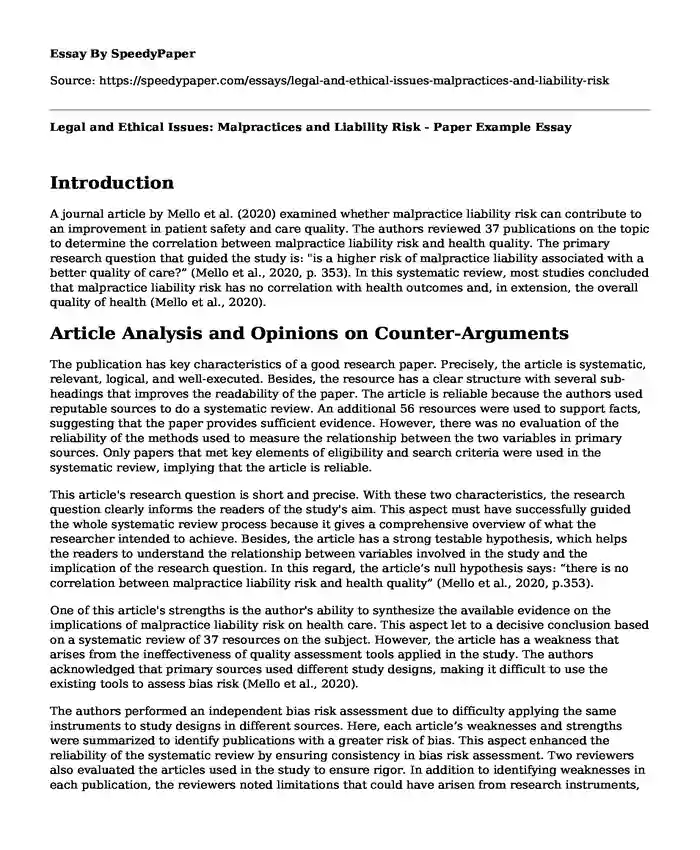
| Type of paper: | Essay |
| Categories: | Law Ethics Social issue |
| Pages: | 3 |
| Wordcount: | 642 words |
Introduction
A journal article by Mello et al. (2020) examined whether malpractice liability risk can contribute to an improvement in patient safety and care quality. The authors reviewed 37 publications on the topic to determine the correlation between malpractice liability risk and health quality. The primary research question that guided the study is: "is a higher risk of malpractice liability associated with a better quality of care?” (Mello et al., 2020, p. 353). In this systematic review, most studies concluded that malpractice liability risk has no correlation with health outcomes and, in extension, the overall quality of health (Mello et al., 2020).
Article Analysis and Opinions on Counter-Arguments
The publication has key characteristics of a good research paper. Precisely, the article is systematic, relevant, logical, and well-executed. Besides, the resource has a clear structure with several sub-headings that improves the readability of the paper. The article is reliable because the authors used reputable sources to do a systematic review. An additional 56 resources were used to support facts, suggesting that the paper provides sufficient evidence. However, there was no evaluation of the reliability of the methods used to measure the relationship between the two variables in primary sources. Only papers that met key elements of eligibility and search criteria were used in the systematic review, implying that the article is reliable.
This article's research question is short and precise. With these two characteristics, the research question clearly informs the readers of the study's aim. This aspect must have successfully guided the whole systematic review process because it gives a comprehensive overview of what the researcher intended to achieve. Besides, the article has a strong testable hypothesis, which helps the readers to understand the relationship between variables involved in the study and the implication of the research question. In this regard, the article’s null hypothesis says: “there is no correlation between malpractice liability risk and health quality” (Mello et al., 2020, p.353).
One of this article's strengths is the author's ability to synthesize the available evidence on the implications of malpractice liability risk on health care. This aspect let to a decisive conclusion based on a systematic review of 37 resources on the subject. However, the article has a weakness that arises from the ineffectiveness of quality assessment tools applied in the study. The authors acknowledged that primary sources used different study designs, making it difficult to use the existing tools to assess bias risk (Mello et al., 2020).
The authors performed an independent bias risk assessment due to difficulty applying the same instruments to study designs in different sources. Here, each article’s weaknesses and strengths were summarized to identify publications with a greater risk of bias. This aspect enhanced the reliability of the systematic review by ensuring consistency in bias risk assessment. Two reviewers also evaluated the articles used in the study to ensure rigor. In addition to identifying weaknesses in each publication, the reviewers noted limitations that could have arisen from research instruments, sample size, and data sources. Together, these measures enhance the relevance of the article in policy-making concerning malpractice liability risk.
The paper presents a strong counter-argument that refutes a claim that liability risk has no deterrence effect on malpractices. In this regard, the counter-argument says that many professionals would develop good conduct in response to the threat of being sued for malpractices (Mello et al., 2020). It further states that malpractice liability risk is necessary to compel clinicians to calibrate safety responses and ensure that health benefits always exceed risks (Mello et al., 2020). In my opinion, the counter-argument is more persuasive because liability risk deters malpractices by discouraging employees from engaging in improper conduct.
Reference
Mello, M. M., Frakes, M. D., Blumenkranz, E., & Studdert, D. M. (2020). Malpractice liability and health care quality. Journal of the American Medical Association, 323(4), 352-365. https://doi.org/10.1001/jama.2019.21411
Cite this page
Legal and Ethical Issues: Malpractices and Liability Risk - Paper Example. (2023, Dec 28). Retrieved from https://speedypaper.net/essays/legal-and-ethical-issues-malpractices-and-liability-risk
Request Removal
If you are the original author of this essay and no longer wish to have it published on the SpeedyPaper website, please click below to request its removal:
- Essay Example on the Ethics of Legal Marijuana
- Free Essay Sample on Florida Law on Domestic Abuse
- Essay Example on Russian Mafia Versus Italian Mafia
- Free Essay Sample. Paternalism
- Proposal Policy for the Purpose of Marijuana - Paper Example
- Paper Example on Privacy: An Inalienable Right of All People, But Not for All?
- The Spring Valley Case Study
Popular categories




